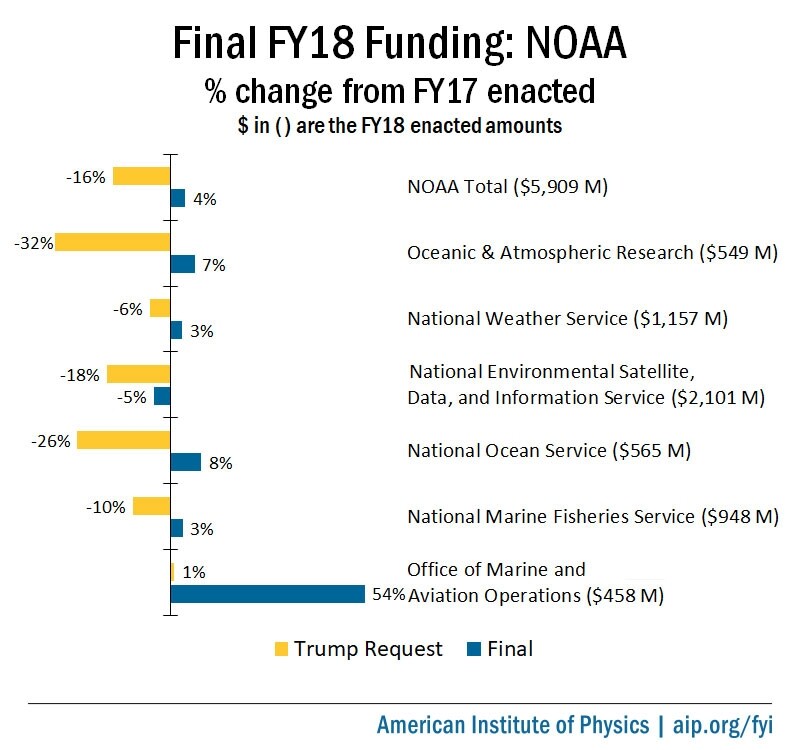
Final FY18 Appropriations: National Oceanic and Atmospheric Administration
The final appropriations legislation for fiscal year 2018 provides the National Oceanic and Atmospheric Administration with a $234 million, or 4 percent, funding increase over the fiscal year 2017 enacted level to $5.9 billion.
A substantial portion of the increase is dedicated to funding weather research and infrastructure authorized in the Weather Research and Forecasting Innovation Act that Congress enacted
Overall funding for OAR is increasing by 7 percent to $549 million, while the National Weather Service (NWS) is slated for a 3 percent boost to $1.2 billion. Funding for the National Environmental Satellite, Data and Information Service (NESDIS) is cut 5 percent to $2.1 billion, reflecting ramp downs in activity in NOAA’s flagship satellite programs.


Congress’ joint House-Senate explanatory statement with additional budget details and other policy guidance is available here
Office of Oceanic and Atmospheric Research
Funding for OAR, NOAA’s research line office, will rise 7 percent to $549 million.
Climate research funding held flat. Although NOAA’s Climate Research account was targeted for deep cuts in both the Trump administration’s request and the House’s proposal, Congress decided to maintain its funding at $158 million.
Within Climate Research, the Senate report also directs NOAA to fund Arctic research at “no less than” the current level. The House and Senate reports both specify at least level funding for the National Integrated Drought Information System (NIDIS) and express support for expansion of the Regional Drought Early Warning Information System.
Weather research boosted. The Weather and Air Chemistry Research is increasing 16 percent to $132 million, an amount equal to the level authorized in the Weather Research and Forecasting Innovation Act.
In general, the statement asserts that this year’s appropriations provided for NOAA are “consistent” with the weather law. Funding for the Joint Technology Transfer Initiative, which facilitates weather research-to-operations from OAR to the NWS, will double to $20 million. The extramural U.S. Weather Research Program and the Tornado Severe Storm Research / Phased Array Radar program will each receive $13 million. The Senate report also specifies that within the U.S. Weather Research Program, up to $2 million will go toward extramural research on infrasonic weather monitoring and at least $2.6 million toward Airborne Phased Array Radar R&D.
Warning against any future cuts to cooperative institutes issued. The Senate report underscores that Congress “continues to strongly support well established [cooperative] institutes” and “expects the administration to fully fund Cooperative Institutes at appropriate levels in future years.”
Research supercomputing receives spending surge. Funding for Research Supercomputing procurement is growing 13 percent to $41 million. The Senate report directs $15 million of this amount to support ongoing development of a dedicated high-performance computing facility.
VORTEX-Southeast program protected. Both the House and Senate reports reject the administration’s proposed elimination of the $5 million Vortex-SE tornado research program focused on the southeastern U.S.
Sea Grant sees an increase. Congress rejects the administration’s proposed elimination of the National Sea Grant Program, which supports coastal and marine related research, extension, and education activities across the nation, instead increasing its funding by $2 million to $65 million.
National Weather Service
The NWS budget is set to increase by 3 percent to $1.2 billion. Four of five major accounts that comprise NWS — Observations; Analyze, Forecast, and Support; Dissemination; and Science and Technology Integration — are slated to receive 3 percent to 5 percent increases. The fifth account, Central Processing, will remain flat.
Staffing issues an ongoing concern. Citing concerns over the number of vacancies within NWS, the statement adopts Senate report language directing NOAA to include “a separate accounting of all NWS filled and open positions, including length of time the positions have been unfilled” in its 2018 spend plan, and clarifies it should distinguish between funded and unfunded vacancies. The statement also directs NOAA to provide quarterly briefings to Congress on all NWS management and budget issues.
National Centers for Environmental Prediction restructure rejected. The Senate report rejects the administration’s proposal to consolidate the Climate Prediction Center into the Weather Prediction Center.
Sub-seasonal to seasonal prediction programs protected. The House and Senate reports reject the administration’s request to decrease funding for mid-range weather outlooks, including sub-seasonal to seasonal phenomena. Further, the Senate report specifies “no less than” current funding amounts for these programs. Acting Administrator Tim Gallaudet has identified
Need for hurricane forecasting improvements emphasized. The Senate report encourages NOAA to “reduce errors in tracking and intensity forecasts of hurricanes by identifying technology and methods available to significantly improve hurricane forecasting.”
National Water Center and Model supported. The statement reiterates Senate report language in support of the National Water Center (NWC), which serves as the agency’s clearinghouse for national water forecasting research and capabilities, including the National Water Model (NWM). The Senate report instructs NOAA to provide “not less than” the current funding amount for NWC and rejects any planned delays for upgrades to the NWM.
On top of the NWC budget, the statement specifies an additional $6 million for NWS to support collaborative efforts to “improve fine and large-scale measurements of snow depth and soil moisture data” that can be incorporated into the NWM.
Repair and maintenance of facilities funded. The statement provides $16 million for major repairs and deferred maintenance requirements at NWS weather forecast offices, almost doubling the administration’s requested amount. It also instructs NWS to submit a report before using the funding that includes a prioritized list and estimated total amount needed to address NWS deferred maintenance needs.
Minimum set for ocean observation network availability. The Senate report provides funding for the National Buoy Data Center to maintain at least 80 percent network availability of its meteorological and ocean observing platforms. It also directs NOAA to provide adequate funding for the TAO and DART arrays and to develop a schedule for restoring existing data buoy operability and a strategy for minimizing future outages.
Tsunami research program cuts rejected. Both the House and Senate reports reject the administration’s proposed $11 million reduction to the Tsunami Research and Operational Warning program and consolidation of activities into a single Tsunami Warning Center.
National Environmental Satellite, Data and Information Service
Funding for NESDIS is set to decrease by 5 percent to $2.1 billion.
Flagship weather satellite funding ramping down as planned. With the two latest Geostationary Operational Environmental Satellite–R series satellites having launched successfully last year and earlier this year, funding for the program is declining, as scheduled, by 31 percent to $519 million.
Meanwhile, the Joint Polar Satellite System budget is decreasing as planned by 2 percent to $776 million, following the successful launch of JPSS-1 last year.
Polar Follow On fully funded. The statement specifies $419 million for the Polar Follow On (PFO) program, the full amount NOAA has said is required to keep the program on track to meet its target satellite launch dates in fiscal years 2026 and 2031. The Senate report, which rejected the administration’s request to reduce PFO funding by 45 percent, underscores the importance of consistent funding for the PFO program:
Funding for PFO is critical for maintaining polar orbiting satellite data. … These satellites provide 85 percent of data required for the [NWS’] Numerical Weather Prediction models. These data are required for accurate forecasts 3-7 days in advance of a severe weather event, including hurricanes and superstorms. … In light of the critical role that these satellites play in protecting American lives and property, the Committee finds it perplexing that the Department of Commerce and NOAA would propose to cut this program. This cut … would introduce a weather forecasting risk that this Committee is unwilling to accept.
Space Weather Follow On boosted. The statement specifies $8.5 million for the Space Weather Follow On satellite, a 71 percent increase over last year and $8 million more than requested by the administration. It also reinforces guidance provided in the House report to NOAA to “refine” the mission concept and requirements.
National Centers for Environmental Information. Funding for the National Centers for Environmental Information (NCEI) — which hosts and provides public access to oceanic, atmospheric, and geophysical data and information — is increasing by 2 percent to $61 million. The House and Senate reports also reject the administration’s request to slash funding NCEI’s Regional Climate Centers, with the Senate report further specifying level funding for the centers.
Commercial Weather Data Pilot. The statement provides $6 million for the Commercial Weather Data Pilot, the full amount authorized in the weather law. The program assesses the potential use of commercial weather data in NOAA weather modeling and forecasting.
Office of Marine and Aviation Operations
New Hurricane Hunter plane. Funding for the Office of Marine and Aviation Operations is increasing $160 million, or 54 percent to $458 million. The statement directs $121 million of that amount towards the acquisition of a new Gulfstream IV Hurricane Hunter aircraft as backup for current aircraft capabilities.
Office of Education
The statement rejects the administration’s proposal to eliminate NOAA’s $27 million Office of Education, instead specifying a $1 million increase directed toward the Education Partnership Program and Minority Serving Institutions.




